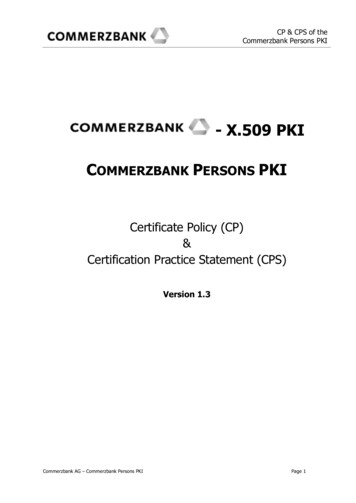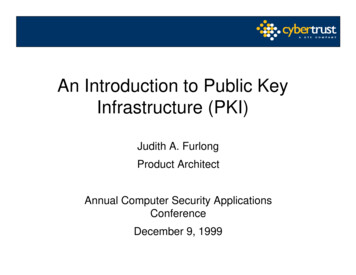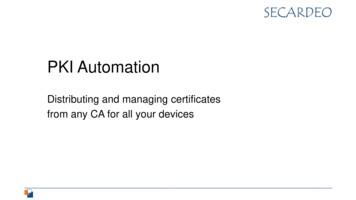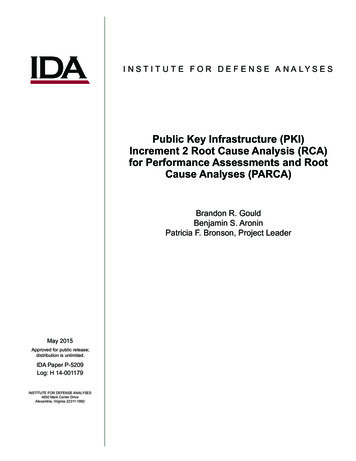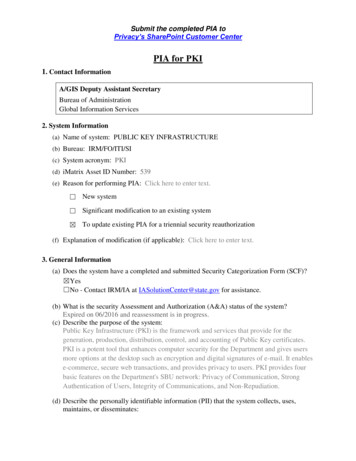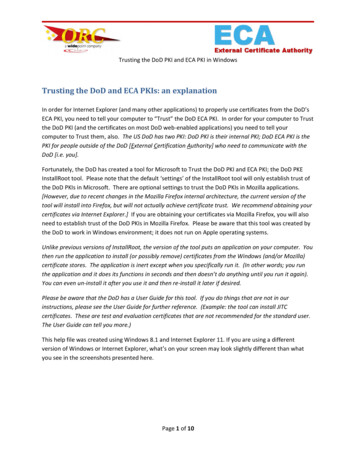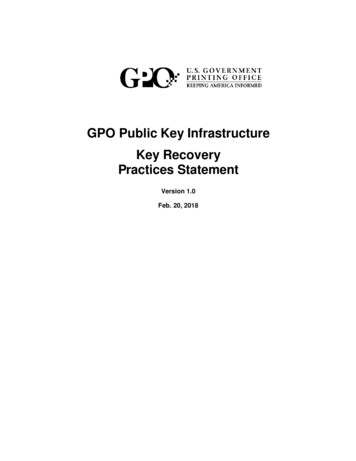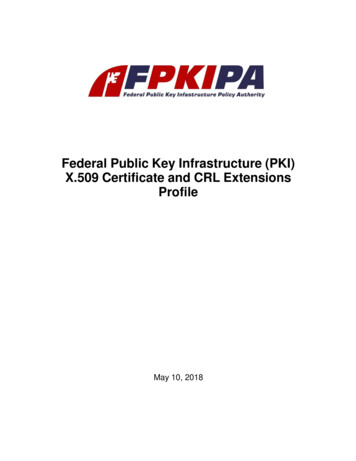
Transcription
Federal Public Key Infrastructure (PKI)X.509 Certificate and CRL ExtensionsProfileMay 10, 2018
Document HistoryStatusRelease ved10/12/2005Draft10/31/2012Incorporates changes for FBCA Change Proposal2011-6 – Remove Requirements for LDAP URIs .Updated references, RFC 5289 in place of 3280,added RFC 4055, 5758, 2560, 3279, RFC 2616replaced 1738, RFC 4516 in place of 2255, RFC5751 replaced 3851, RFC 4514 replaced 2253,Approved5/5/2015Incorporate changes for FBCA Change Proposal2015-1 – make anyEKU optional when EKU isasserted in digital signature certificates.FPKICommunity7/17/2017Align with current practice and FBCA CP v2.31FPKICommunityApproved1.8No longer allow IP in URIs used in certificates Approved1.95/10/2018Specify only minimum key size for Root CADeleted comment about discouraging theuse of policy QualifiersInclude Policy Constraints – non-critical –exception from RFC 5280Include InhibitAnyPolicy – non-critical –exception from RFC 52802018-03 Mandate specific EKU in CommonPolicy subscriber certificates to align withIndustry Practices1FPKICommunityMay 10, 2018
1. IntroductionThis document specifies the X.509 version 3 certificate and version 2 certificaterevocation list (CRL) profiles for Federal public key infrastructure (FPKI) systems. Theprofiles serve to identify unique parameter settings for Federal public key infrastructuresystems.In the interest of establishing commonality and interoperability among PKI communitiesoutside the Federal government, it was decided that this profile should be based on a"standard PKI profile" but still contain the unique parameter settings for Federal systems.The most widely accepted PKI profile is RFC 5280 developed by the PKIX workinggroup. The PKIX profile, Internet X.509 Public Key Infrastructure Certificate andCertificate Revocation List (CRL) Profile, identifies the format and semantics ofcertificates and CRLs for the Internet PKI. Procedures are described for processing andvalidating certification paths in the Internet environment. Encoding rules are provided forall fields and extensions profiled in both the X.509 v3 certificate and v2 CRL. Encodingrules for cryptographic algorithms specified in this profile are specified in RFC 3279,RFC 4055, and RFC 5758.This FPKI profile complements the current PKIX profile. If a specific program needs toimplement a subset of the FPKI certificate and/or CRL profile, the program should tailortheir X.509 certificate and/or CRL profile using the parameters stipulated in thisdocument together with the parameters stipulated in PKIX. Parameters stipulated in thisdocument should take precedence. Any program deciding to tailor their FPKI-compliantX.509 certificates and/or CRLs to meet their specific needs must document the intendedsubset profile (referencing the FPKI profile as a basis) so that the certificate generationelement will know how to populate the program-specific certificates.The current version of this profile includes requirements that did not appear in previousversions. Operators of existing CAs are not encouraged to re-issue any certificates forthe sole purpose of complying with this version of the profile. However, operatorsshould make preparations to begin issuing all new certificates in conformance with theprofile.1.1. StructureThis document is divided into six sections. Section 1 includes this introduction. Sections2 and 3 describe the v3 certificate and v2 CRL respectively. These sections specificallydescribe the differences in generation and processing requirements between the PKIXprofile and FPKI profile. Unless otherwise noted in this profile, the reader should followthe PKIX generation and processing requirements for a particular field. Section 4specifies rules for choosing character encoding sets for attribute values of typeDirectoryString in distinguished names. Section 5 profiles the use of uniform resourceidentifiers (URIs) in certificates. Section 6 provides guidance on the selection ofalgorithms for signing certificates and CRLs and for the selection of public key types.Section 7 provides an overview of each of the certificate and CRL profiles included in theworksheets at the end of this document.1.2. AcronymsCACertification Authority2May 10, 2018
DAPNISTPKIPKIXPVMRDNRFCRSAURIv2v3Cryptographic Message SyntaxCertificate Revocation ListDistinguished Encoding RulesDiffie-HellmanDistinguished NameDigital Signature AlgorithmElliptic Curve CryptographyElliptic Curve Diffie-HellmanElliptic Curve Digital Signature AlgorithmFederal Bridge Certification AuthorityFederal Public Key InfrastructureHypertext Transfer ProtocolInternet Engineering Task ForceInternet ProtocolKey Exchange AlgorithmLightweight Directory Access ProtocolNational Institute of Standards and TechnologyPublic Key InfrastructurePublic Key Infrastructure (X.509)Path Validation ModuleRelative Distinguished NameRequest For CommentsRivest-Shamir-AdelmanUniform Resource Identifierversion 2version 31.3. ion, Version 0.5, May 2004.[2]Russell Housley and Paul Hoffman. Internet X.509 Public Key Infrastructure:Operational Protocols: FTP and HTTP, RFC2585, May 1999.[3]David Cooper, Stefan Santesson, Stephen Farrell, Sharon Boeyen, Russell Housley,and Tim Polk. Internet X.509 Public Key Infrastructure Certificate and CertificateRevocation List (CRL) Profile, RFC5280, May 2008.Mark Smith and Tim Howes. Lightweight Directory Access Protocol (LDAP):Uniform Resource Locator, RFC4516, June 2006.[4][5]Roy T. Fielding, James Gettys, Jeffrey C. Mogul, Henrik Frystyk Nielsen, LarryMasinter, Paul J. Leach, and Tim Berners-Lee. Hypertext Transfer Protocol -HTTP/1.1, RFC2616, June 1999.[6]Steve Lloyd. AKID/SKIDImplementationGuideline, September 2002.[7]Michael Myers, Rich Ankney, Ambarish Malpani, Slava Galperin, and CarlisleAdams. Internet X.509 Public Key Infrastructure: Online Certificate StatusProtocol – OCSP, RFC2560, June 1999.3May 10, 2018
[8]Tim Polk, Russell Housley, and Larry Bassham. Internet Public Key Infrastructure:Algorithms and Identifiers for the Internet X.509 Public Key InfrastructureCertificate and CRL Profile, RFC3279, April 2002.[9]Blake Ramsdell and Sean Turner. Secure/Multipurpose Internet Mail Extensions(S/MIME) Version 3.2 Message Specification, RFC5751, January 2010.[10] Kurt D. Zeilenga. Lightweight Directory Access Protocol (LDAP): StringRepresentation of Distinguished Names, RFC4514, June 2006.[11] Jim Schaad, Burt Kaliski, and Russell Housley. Additional Algorithms andIdentifiers for RSA Cryptography for use in the Internet X.509 Public KeyInfrastructure Certificate and Certificate Revocation List (CRL) Profile , RFC4055,June 2005.[12] Quynh Dang, Stefan Santesson, Kathleen M. Moriarty, Daniel R. L. Brown, andTim Polk. Internet X.509 Public Key Infrastructure: Additional Algorithms andIdentifiers for DSA and ECDSA, RFC5758, January 2010.2. X.509 v3 CertificatesX.509 v3 certificates contain the identity and attribute data of a subject using the basecertificate with applicable extensions. The base certificate contains such information asthe version number of the certificate, the certificate’s identifying serial number, thesignature algorithm used to sign the certificate, the issuer’s distinguished name, thevalidity period of the certificate, the distinguished name of the subject, and informationabout the subject’s public key. To this base certificate are appended numerous certificateextensions. More detailed information about X.509 certificates can be found inRecommendation X.509 and RFC 5280.CAs create certificates for user authentication procedures that require one user to obtainanother user’s public key. So that users trust the public key, the CA employs a digitalsignature to cryptographically sign the certificate in order to provide assurance that theinformation within the certificate is correct. The fields in a certificate identify the issuer(i.e., CA), subject (i.e., user), version number, subject’s public key, validity period, andserial number of the certificate along with the public key algorithm used to certify thecertificate. A CA may also add certificate extensions containing additional informationabout the user or the CA, depending on the implementation.All certification paths start from a trust anchor. A trust anchor is a CA that a user trusts toissue certificates based on out-of-band knowledge. The public key of a trust anchor isdistributed to certificate users in the form of a "trust anchor certificate." A trust anchorcertificate: is self-signed, that is, signed with the private key corresponding to the public keycontained in the subject public key field of the certificate; 1contains any needed parameters in the subject public key info field, where thedigital signature algorithm used in the certificate requires the use of parameters;1 1NOTE: While in most cases, the public key of a CA that is to act as a trust anchor is distributed using selfsigned certificates, this is not strictly necessary. Relying parties may obtain the public key of a trust anchor byother means.4May 10, 2018
contains few or no extensions; is kept in protected memory or otherwise protected from alteration by an intruder; is transferred to the application or certificate using system in an authenticatedmanner. The signature on the trust anchor certificate cannot authenticate thecertificate.There is no single trust anchor for the entire Federal Government, although A-130 statesall public key infrastructure (PKI) certificates used by an agency and issued inaccordance with Federal PKI policy validate to the Federal PKI trust anchor operated bythe FPKI Management Authority when being used for user signing, encrypting purposes,authentication and authorization. The trust anchor used by a certificate using applicationmay be the CA that issued it a certificate or may be a CA that is at the top of a hierarchyof CAs. Which trust anchors may be used by agency certificate using systems to startcertification paths is a matter of agency security policy.The CAs in the FPKI may be cross-certified with each other. In order to facilitate secureintra-agency communication, CAs within the FPKI may either cross-certify with eachother directly or may cross-certify with the FPKI either with the Federal BridgeCertification Authority (FBCA) or Federal Common Policy Certification Authority(FCPCA). In general, cross-certification with the FPKI is the preferable option since itmaximizes inter-agency connectivity while minimizing the number of cross-certificationsthat any given CA needs to maintain.Any certificate using system in the FPKI can view any CA in the FPKI as the trust anchorfor starting certification paths, provided:1. the certificate using system has an authenticated copy of the trust anchor's selfsigned certificate; and,2. local agency security policy allows the use of that CA as a trust anchor.Agencies will designate the CAs that may be used as trust anchors by certificate usingsystems within the agency, and will establish the approved mechanisms for obtaining thetrust anchors' public keys in a secure, authenticated manner. The FPKIMA will make theself-signed certificate of the Common Policy Root CA available for use as a trust anchor,and it is expected that this CA will be used as the trust anchor for most users who areissued certificates under the Common Policy.X.509 v3 certificates provide a mechanism for CAs to append additional information aboutthe subject’s public key, issuer’s public key, and issuer’s CRLs. Standard certificateextensions are defined for X.509 v3 certificates. These extensions provide methods forincreasing the amount of information the X.509 certificate conveys to facilitate automatedcertificate processing.5May 10, 2018
3. X.509 v2 Certificate Revocation ListsCAs use CRLs to publicize the revocation of a subject’s certificate. The CRLs are storedin the directory as attributes and are checked by relying parties to verify that a user’scertificate has not been revoked. The fields in a CRL identify the issuer, the date thecurrent CRL was generated, the date by which the next CRL will be generated, and therevoked users’ certificates.If a CA issues a large number of certificates, then the use of distribution points isencouraged in order to ensure that CRLs do not become too large. However, distributionpoints should not be specified as nameRelativeToIssuer since the NIST Recommendationfor X.509 Path Validation [1] does not require Bridge-enabled PVMs to be able toprocess this feature. For the same reason, the use of indirect CRLs and CRLs segmentedby reason code is discouraged. CAs that issue segmented CRLs are strongly encouragedto also issue full CRLs in order to accommodate third parties that use CRLs to generateOCSP responses.Since Bridge-enabled PVMs PP are not required to be able to process delta-CRLs, CAsshould not assume that relying parties can process them. However, CAs may still chooseto issue delta-CRLs in addition to complete for scope CRLs in order to improve efficiencyfor those relying parties that can process the delta-CRLs.CAs may optionally supplement the CRL based revocation mechanisms with on-linerevocation mechanisms.When an OCSP server is available that provides status information about acertificate, then the authorityInfoAccess extension for that certificate shall include apointer to the OCSP server.4. Encoding Distinguished NamesX.509 certificates and CRLs include distinguished names (DNs) to identify issuers ofcertificates and CRLs, subjects of certificates, and CRL distribution points. A DNconsists of a sequence of relative distinguished names (RDNs) where each RDN consistsof a set of attribute type and value pairs. In most cases, an RDN will only include asingle attribute type and value pair, but in some cases the use of a multi-valued RDN (i.e.,an RDN that includes more than one attribute type and value pair) may be appropriate. Ingeneral, multi-valued RDNs should not be included in DN that identify CAs or CRLdistribution points. When multi-valued RDNs are included in DNs that identify endentities, they should only be included in the final RDN in the DN (i.e., the RDN thatappears first when the DN is written as specified in RFC 4514) and no multi-valued RDNshould include two instances of an attribute type.Many of the attributes in distinguished names use the DirectoryString syntax.DirectoryString permits encoding of names in a choice of character sets: PrintableString,TeletexString, BMPString, UniversalString, and UTF8String. PrintableString is currentlythe most widely used encoding for attribute values in distinguished names.PrintableString is a subset of ASCII; it does not include characters required for mostinternational languages. UTF8String is an encoding that supports all recognized writtenlanguages, including some ancient languages (e.g., Runic).6May 10, 2018
Name comparison is an important step in X.509 path validation, particularly for namechaining and name constraints computation. Many legacy implementations are unable toperform name comparisons when names are encoded using different character sets. Tosimplify correct operation of path validation, CAs are strongly encouraged to honor thesubject’s chosen character set when issuing CA certificates or populating extensions.That is, if a subject CA encodes its own name in the issuer field of certificates and CRLs itgenerates using TeletexString, the cross-certificate should use the same character set tospecify that CA’s name.Name constraints are specified in CA certificates. The names specified in nameconstraints must be compared with the subject names in subsequent certificates in acertification path. To help ensure that name constraints are applied correctly, CAs shouldencode each attribute value in a name constraint using the same encoding as is used toencode the corresponding attribute value in subject names in subsequent certificates. Ingeneral, this may be accomplished by encoding attribute values in the name constraintsextension of a certificate in the same way as they are encoded in the subject name of thecertificate.Subject names in end entity certificates do not figure in name chaining, but are used tovalidate name constraints. In order to ensure that name constraints can be computedcorrectly, attribute values that are shared between an end entity and its certificate issuershould be encoded identically. Attribute values in end entity names that are unique to theend entity (e.g., the common name) may be encoded in PrintableString or UTF8Stringwithout concern for name comparison issues.Attributes of type DirectoryString in the distinguished names of new CAs should beencoded using the PrintableString encoding wherever possible. When the attribute valuecannot be encoding using PrinableString, the UTF8String encoding should be used.However, if the new CA is being added to an existing PKI, attribute values in the newCA's DN that are shared with the DNs of pre-existing CAs may use the same encoding aswas used in the DNs of the pre-existing CAs. As products that compare names encoded indifferent character sets become available, CAs should transition to either PrintableStringor UTF8String encodings when they roll over to new key pairs.For CAs within the Federal PKI, all attributes of type DirectoryString should be encodedusing the PrintableString encoding. However, the common name attribute of end entitycertificates may be encoded in UTF8String if the subject's name cannot be encoded usingPrintableString.5. Use of URIs in Distribution Points, authorityInfoAccess, andsubjectInfoAccess ExtensionsUniform Resource Identifiers (URIs) are used in five different extensions within thecertificate and CRL profiles in this document: cRLDistributionPoints,issuingDistributionPoint, FreshestCRL, authorityInfoAccess, and subjectInfoAccess.Two different protocols are used in this document: LDAP and HTTP. The specificationsfor URIs for these protocols may be found in RFC 4516 and RFC 2616, respectively.Except for the id-ad-ocsp access method of the authorityInfoAccess extension, all URIsshould have a prefix of "ldap" or "http" to indicate that the relevant information is7May 10, 2018
locatedin an LDAP accessible directory or via HTTP. For the id-ad-ocsp access method ofthe authorityInfoAccess, the URI should have a prefix of "http" to indicate that thetransport protocol for the OCSP request/response messages is HTTP. The hostname ofevery URI should be specified as a fully qualified domain name. The port number of theserver must be specified if it is not the default port number for the relevant protocol (80for HTTP and 389 for LDAP).In the cRLDistributionPoints and FreshestCRL extensions, the URI is a pointer toa current CRL that provides status information about the certificate. If LDAP isused, the URI must include the DN of the entry containing the CRL and specifythe directory attribute in which the CRL is located , or deltaRevocationList). If the directory in which theCRL is stored expects the "binary" option to be specified, then the attribute typemust be followed by ";binary" in the URI. If HTTP is used, the URI must point toa file that has an extension of ".crl" that contains the DER encoded CRL (see RFC2585). When a URI is used as the DistributionPointName in theissuingDistributionPoint extension in a CRL, the value must match the URI in thecorresponding distribution points in the cRLDistributionPoints extensions incertificates covered by the CRL.Some examples of URIs that may appear in a cRLDistributionPoints,FreshestCRL, or issuingDistributionPoint extension /fictitiousCRL1.crlldap://smime2.nist.gov/cn Good%20CA,o Test%20Certificates,c .71/cn onlyContainsCACerts%20CA,o Test%20Certificates,c US?authorityRevocationList;binaryThe authorityInfoAccess extension uses URIs for two purposes. When the id-adcaIssuers access method is used, the access location specifies where certificatesissued to the issuer of the certificate may be found. If LDAP is used, the URImust include the DN of the entry containing the relevant certificates and specifythe directory attribute(s) (e.g., cACertificate and crossCertificatePair) in which thecertificates are located. If the directory in which the certificates are stored expectsthe "binary" option to be specified, then the attribute type must be followed by";binary" in the URI. If HTTP is used, the URI must point to a file that has anextension of ".p7c" that contains a certs-only CMS message (see RFC 5751). TheCMS message should include all certificates issued to the issuer of this certificate,but must at least contain all certificates issued to the issuer of this certificate inwhich the subject public key may be used to verify the signature on this certificate.For a certificate issued by “Good CA”, some examples of URIs that mayappear as the access location in an authorityInfoAccess extension when the idad-caIssuers access method is used 71/cn Good%20CA,o Test%20Certificates,c yWhen the id-ad-ocsp access method is used, the access location specifies thelocation of an OCSP server that provides status information about the certificate8May 10, 2018
(see RFC 2560).The URI may include a path. Where privacy is a requirement, the URI may have aprefix of "https" to indicate that the transport protocol for OCSPrequests/responses is HTTP over SSL/TLS. In this case, the default port numberis 443, and the URI must include the server's port number if this default portnumber is not used.The id-ad-caRepository access method for the subjectInfoAccess extension usesURIs to specify the location where CA certificates issued by the subject of thecertificate may be found. If LDAP is used, the URI must include the DN of theentry containing the relevant certificates and specify the directory attribute(s)(e.g., cACertificate and crossCertificatePair) in which the certificates are located.If the directory in which the certificates are stored expects the "binary" option tobe specified, then the attribute type must be followed by ";binary" in the URI. IfHTTP is used, the URI must point to a file that has an extension of ".p7c" thatcontains a certs-only CMS message (see RFC 5751). The CMS message shouldinclude all CA certificates issued by the subject of this certificate, but must atleast contain all CA certificates issued by the subject of this certificate in whichthe signature on the certificate may be verified using the subject public key in thiscertificate.If the subject of the certificate only issues end entity certificates, then thesubjectInfoAccess extension may be excluded. If the subject of the certificateissues self- issued certificates (e.g., key rollover certificates), but does not issuecertificates to other CAs, then the LDAP URI in the subjectInfoAccess extensiononly needs to specify the cACertificate attribute.For a certificate issued to “Good CA”, some examples of URIs that may appearas the access location in an subjectInfoAccess extension when the id-adcaRepository access method is used 0.71/cn Good%20CA,o Test%20Certificates,c y6. Certificate and CRL Signing Algorithms and Subject Public Key TypesThis profile permits the use of any FIPS approved algorithm for signing certificatesand CRLs. However, agencies are cautioned against use of the weakest or strongestof these algorithms. Specifically, cryptographic algorithms with 80 bits of securitystrength (e.g., 1024 RSA, 1024 bit DSA, 160 bit ECDSA, and SHA-1) are nearingthe end of their useful cryptographic lifetime. PKIs using these algorithms arestrongly encouraged to migrate to stronger algorithms as soon as possible.Additionally, cryptographic algorithms with more than 256 bits of security strength(e.g., 4096 bit RSA, 384 bit ECDSA, SHA-384, and SHA-512) will greatlyimpact performance. Such algorithms are currently appropriate for highly sensitivedata (e.g., classified data) rather than for general use.9May 10, 2018
7. Worksheet ContentsThis document contains six worksheets. Each worksheet lists mandatorycontents of a particular class of certificates or CRLs. Optional features that willbe widely supported in the Federal PKI are also identified. These features maybe included at the issuer's option. Certificate and CRL issuers may includeadditional information in non-critical extensions for local use, but should notexpect clients in the Federal PKI to process this additional information. Criticalextensions that are not listed in these worksheets must not be included incertificates or CRLs used in the Federal PKI.The six worksheets are:1. The Self-Signed CA Certificate worksheet defines the mandatory and optionalcontents of self-signed certificates issued by CAs in the Federal PKI for use byPKI client systems when establishing trust anchors.2. The Key Rollover CA Certificate worksheet defines the mandatory and optionalcontents of key rollover certificates (self-issued certificates that are not selfsigned).3. The Cross-Certificate worksheet defines the mandatory and optional contents ofcertificates issued by CAs in the Federal PKI where the subject is a CA and thepublic key will be used to verify the signature on certificates. This profile applieswhether the subject CA is considered to be hierarchically subordinate to the issueror is considered to be a peer of the issuer. One optional feature in this worksheetis the use of the public key to verify the signature on CRLs.4. The CRL worksheet defines the mandatory and optional contents of CRLs issuedby CRL issuers in the Federal PKI.5. The End Entity Signature Certificate worksheet defines the mandatory andoptional contents of certificates issued by CAs in the Federal PKI where thesubject is an end entity and the public key will be used to verify the signatures.6. The Key Management Certificate worksheet defines the mandatory and optionalcontents of certificates issued by CAs in the Federal PKI where the subject is anend entity and the public key will be used to perform key management operations(e.g., key transport using RSA or Diffie-Hellman key agreement).Note that the Federal PKI does not absolutely prohibit the use of dual-use end entitycertificates, where an RSA or elliptic curve key is used for both digital signatures and keymanagement. However, dual-use certificates are generally discouraged. As such, aworksheet for dual-use certificates is not supplied with this profile. CAs in the FederalPKI that issue dual-use certificates may use the End Entity Signature Certificate profileand assert the additional key usage bits as appropriate (i.e., key encipherment for RSAkeys or key agreement for elliptic curve keys). Dual-use certificates must not assert thenonRepudiation bit.10May 10, 2018
Worksheet 1: Self-Signed CA Certificate ProfileFieldCriticality FlagValueComments2Integer value of "2" for version 3 certificate.INTEGERUnique positive integerCertificatetbsCertificateFields to be fierMust match Algorithm Identifier in signatureAlgorithm field.The parameters field is only populated when the algorithmis RSA.algorithmparametersChoice of following ion1.2.840.113549.1.1.10id-RSASSA-PSS (RSA with PSS padding; 800-78 requiresuse with SHA-256 hash 16.840.1.101.3.4.2.1or2.16.840.1.101.3.4.2.3For id-RSASSA-PSS only, specify either the SHA-256 orSHA-512 hash algorithm as a parameterNULLFor all RSA algorithms except id-RSASSA-PSSissuerNameWill match the subject peAndValueAttributeTypeOIDAttributeValuesee commentSee section 4.YYMMDDHHMMSSZUse for dates up to and including 2049.YYYYMMDDHHMMSSZUse for dates after 2049.YYMMDDHHMMSSZUse for dates up to and including 2049.YYYYMMDDHHMMSSZUse for dates after erTimeutcTimegeneralTimesubjectNameWill match the issuer peAndValueAttributeTypeOIDAttributeValuesee commentSee section 4.
FieldCriticality rithmIdentifierPublic key algorithm associated with the public key. Maybe either RSA or elliptic 13549.1.1.1RSA1.2.840.10045.2.1Elliptic CurveSee commentFor RSA include NULL. For ECC include parameters.BIT STRINGFor RSA, modulus must be at least 2048 bits. For ECC,public key must be at least 224 bits.OCTET STRINGTypically derived using the SHA-1 hash of the public key.required is extension is required to assist in path development.subjectInfoAccesssubjectInfoAccess consists of a sequence ofaccessMethod and accessLocation pairs. Only one accessmethod is defined for use in CA ad-caRepository(1.3.6.1.5.5.7.48.5)Self-signed certificates must include at least one instanceof this access method that includes the URI name form tospecify the location of an HTTP accessible server.Certificates may also include a URI name form to specifyan LDAP accessible directory server. Each URI mustpoint to a location where CA certificates issued by thesubject of this certificate may be found.
Identifiers for RSA Cryptography for use in the Internet X.509 Public Key Infrastructure Certificate and Certificate Revocation List (CRL) Profile, RFC4055, June 2005. [12] Quynh Dang, Stefan Santesson, Kathleen M. Moriarty, Daniel R. L. Brown, and Tim Polk. Internet X.509 Public Key Infrastructure: Additional Algorithms and

